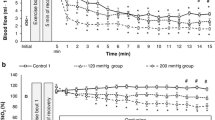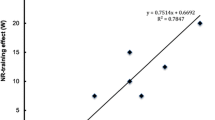Summary
Recovery from muscle fatigue after exercise is known to have two beneficial effects: improved blood lactate elimination and a central nervous recuperation of the capacity for exercise. This study indicates circulatory mechanisms that might limit active recovery. Ten subjects were seated on a cycle ergometer and performed arm cranking exercise at an anaerobic intensity which was for each individual in three periods of 6 min, alternating with recovery intervals of 14 min. In two randomly assigned tests, recovery consisted either of passive sitting (control) or cycling at 80 W for 12 min. Both tests terminated with an identical final passive rest period of 25 min. In the cycling test arm cranking led to a heart rate increase which was further elevated with each repetition, while in the control test no differences were shown among the cranking periods. No corresponding difference was found for oxygen consumption. During the 25 min of final rest, the cycling test showed arterial hypotension and elevated heart rate both of which were absent in the control tests. Venous-occlusion-plethysmography revealed a postcranking forearm hyperaemia. In the cycling test hyperaemia was markedly reduced with the onset of cycling due to vasoconstriction; this effect was absent in the control test. A reduction in blood lactate occurred faster in the cycling test, mainly at the onset of cycling. Total plasma fluid loss combined with forearm fluid uptake was accentuated and prolonged by cycling recovery. Recovery exercise performed by muscles other than those that were fatigued could have led to arterial hypotension (shock-index about 1) through both plasma fluid loss and additional vasodilatation depending on the muscle mass involved. Furthermore it may have caused vasoconstriction in resting lactacid muscles leading to a slower release of lactate.
Similar content being viewed by others
References
Asmussen E, Mazin B (1978a) Recuperation after muscular fatigue by `diverting activities. Eur J Appl Physiol 38:1–7
Asmussen E, Mazin B (1978b) A central nervous component in local muscular fatigue. Eur J Appl Physiol 38:9–15
Beetham WP, Buskirk ER (1958) Effects of dehydration, physical conditioning, and heat acclimatization on the response to passive tilting. J Appl Physiol 13:465–468
Bonen A, Belcastro AN (1976) Comparison of self-selected method on lactic acid removal rates. Med Sci Sports 8:176–178
Cortes CW, Kreider RB, Al-Mandalavi S, Lambert J, Johnson KD, Thomson WR, Anderson HN (1988) Lactate clearance during active and passive recovery. Ann Sport Med 4:26–28
Dill DB, Costill DL (1974) Calculation of percentage changes in volume of plasma and red cells in dehydration. J Appl Physiol 37:247–248
Dodd S, Powers SK, Callender T, Brooks E (1984) Blood lactate disappearance at various intensities of recovery exercise. J Appl Physiol 57:1462–1465
Elsner RW, Carlson LD (1962) Postexercise hyperemia in trained and untrained subjects. J Appl Physiol 17:436–440
Evans BW, Cureton KJ (1983) Effect of physical conditioning on blood lactate disappearance after supramaximal exercise. Brit J Sports Med 17:40–45
Gisolfi C, Robinson S, Turrell ES (1966) Effects of aerobic work performed during recovery from exhaustive work. J Appl Physiol 21:1767–1772
Greenleaf JE, Brock PJ, Haines RF, Rositano SA, Montgomery LD, Keil LC (1977) Effect of hypovolemia, infusion and oral rehydration on plasma electrolytes, ADH, renin activity, and +G-tolerance. Aviat Space Environ Med 48:693–700
Harrison MH, Hill LC, Spaul WA, Greenleaf JE (1986) Effect on hydration on some orthostatic and haematological responses to head-up tilt. Eur J Appl Physiol 55:187–194
Hermansen L, Stensvold I (1972) Production and removal of lactate during exercise in man. Acta Physiol Scand 86:191–201
Hildebrandt W, Schütze H, Stegemann J (1991) On the reliability of the Penaz cuff during systemic and local fingertip vasodilatation at rest and in exercise. Eur J Appl Physiol 62:175–179
Hill DW, Lowe HJ (1973) The use of the electrical-impedance technique for the monitoring of cardiac output and limb bloodflow during anaesthesia. Med Biol Eng 11:534–545
Johnson JM, Rowell LB (1975) Forearm skin and muscle vascular responses to prolonged leg exercise in man. J Appl Physiol 39:920–924
Karlsson J, Bonde-Petersen F, Henrikson J, Knuttgen HG (1975) Effects of previous exercise with arms and legs on metabolism and performance in exhaustive exercise. J Appl Physiol 38:763–767
Lewis DH, Mellander S (1962) Competitive effects of sympathetic control and tissue metabolites on resistance and capacitance vessels and capillary filtration in skeletal muscle. Acta Physiol Scand 56:162–188
McCloskey DI, Mitchell JH (1972) Reflex cardiovascular and respiratory responses originating in exercising muscle. J Physiol (Lond) 224:173–186
McGrail JC, Bonen A, Belcastro AN (1978) Dependance of lactate removal on muscle metabolism in man. Eur J Appl Physiol 39:89–97
Miles DS, Sawka MN, Glaser RM, Petrofsky JS (1983) Plasma volume shift during progressive arm and leg exercise. J Appl Physiol 54:491–495
Milesis CA, Fougeron MG, Graham H (1982) Effect of active vs passive recovery on cardiac time components. J Sports Med Phys Fitness 22:147–153
Mitchell JH, Schmidt RF (1983) Vascular reflex control by afferent fibers from skeletal muscle receptors. In: Shepherd JT, Abboud FM (eds) Handbook of physiology, section 2, vol. III, part 2. The cardiovascular system. American Physiological Society, Bethesda, Md., pp 623–658
Morganroth ML, Young EW, Sparks HV (1977) Prostaglandin and histaminergic mediation of prolonged vasodilatation after exercise. Am J Physiol 233:H27-H33
Müller EA (1961) Die physische Ermüdung. In: Bqaader EW von (ed) Handbuch der gesamten Arbeitsmedizin, vol. I. Urban and Schwarzenberg, Munich, pp 423–428
Nyboer J (1972) Workable volume and flow concepts of bio segments by electrical impedance plethysmography. TIT Life Sci 2:1–13
Penaz J, Voigt A, Teichmann W (1976) Beitrag zur fortlaufenden indirekten Blutdruckmessung. Zentralbl Inn Med 31:1030–1033
Remensnyder JP, Mitchell JH, Sarnoff SJ (1962) Functional sympatholysis during muscular activity. Circ Res 11:370–380
Sahlin K, Harris RC, Nylind B, Hultmann E (1976) Lactate content and pH in muscle samples obtained after dynamic exercise. Pflügers Arch 367:143–149
Saltin B (1964) Circulatory response to submaximal and maximal exercise after thermal dehydration. J Appl Physiol 19:1125–1132
Sechenov IM (1935) Zur Frage nach der Einwirkung sensitiver Reize auf die Muskelarbeit des Menschen. In: Sechenov Selected works. Moscow, pp 246–260
Shvartz E, Meroz A, Magazanik A, Shoenfeld Y, Shapiro Y (1977) Exercise and heat orthostatism and the effect of heat acclimation and physical fitness. Aviat Space Environ Med 48:836–842
Stamford BA, Weltman A, Moffatt, Sady S (1981) Exercise recovery above and below anaerobic threshold following maximal work. J Appl Physiol 51:840–844
Stegemann J (1963) Zum Mechanismus der Pulsfrequenzeinstellung durch den Stoffwechsel I, II, III, IV. Pflügers Arch 276:481–524
Stegemann J (1976) Rechnergesteuerte Spiroergometrie nach der Methode der Einzelatemzuganalyse. Sportarzt Sportmed 27:17
Stick C (1981) Zur Problematik der Messung filtrationsbedingter Volumenanderungen der Extremitäten mit der Impedanzplethysmographie. Eur J Appl Physiol 47:405–418
Tibes U, Groth HH (1977) Effect of K+, osmolality, orthophosphate, lactic acid and adrenaline at C-fiber receptors in skeletal muscle. Pflügers Arch 368 [Suppl]: R40, no. 158
Weber E (1914) Eine physiologische Methode, die Leistungsfähigkeit ermüdeter menschlicher Muskeln zu erhöhen. Arch Physiol (Leipzig) 385–420
Weltman A, Regan JD (1983) Prior exhaustive exercise and subsequent, maximal constant load exercise performance. Int J Sports Med 4:184–189
Author information
Authors and Affiliations
Rights and permissions
About this article
Cite this article
Hildebrandt, W., Schütze, H. & Stegemann, J. Cardiovascular limitations of active recovery from strenuous exercise. Europ. J. Appl. Physiol. 64, 250–257 (1992). https://doi.org/10.1007/BF00626288
Accepted:
Issue Date:
DOI: https://doi.org/10.1007/BF00626288




